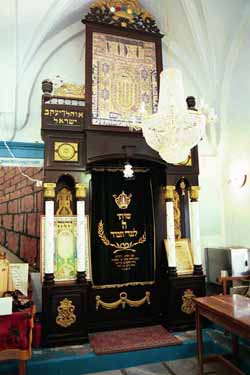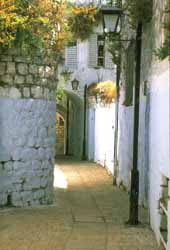e
The 1660 destruction of Safed occurred during the Druze power struggle in Mount Lebanon, at the time of the rule of Ottoman sultan Mehmed IV.[1] [2] [3] [4] The towns of Safed and nearby Tiberias, with substantial Jewish communities, were destroyed in the turmoil.[1] [2] [3] [4] [5] [6] [7] Only a few of the former residents of Safed had returned to the town after the destruction.[6] [7]Sholem considers the 1662 reports about the destruction of Safed as "exaggerated".[8] The community however recovered within several years, whereas Tiberias lay in waste for decades.
Safed: historical context
Safed's central role in Jewish life in Galilee declined after the late 16th century, when it had been a major city with a population of 15,000 Jews.[9] By the second half of the seventeenth century Safed still had a majority Jewish community with 200 "houses" and some 4,000 to 5,000 Jewish residents, while about 100 "houses" (multiple family units) in the town were Muslim.[10] The district was under control of Druze emirs from the Maan family until 1660, when the Ottomans sought to regain local control by reorganizing the sanjaks of Safed and Sidon-Beirut into the newprovince of Sidon.[11] From the 1658 death of Emir Mulhim Ma'n to 1667, a struggle for power between his sons and other Ottoman-backed Druze rulers took place in the region.[12] Mulhim's son Ahmad Maʿn emerged victorious among the Druze, but the Maʿnīs lost control of the area[11] [12] and retreated to the Shuf mountains and Kisrawan.[13] In the second half of the seventeenth century Safed became the capital of the Ottoman sanjak of the same name.
Year of the destruction
Adler, Franco and Mendelssohn claim that the destruction of Safed took place in 1660, Mendelssohn writing that the Jews of Safed "had suffered severely" when the city had been destroyed by the Arabs.[1] [3] [4]
Gershom Scholem places the attack in 1662,[8] and Rappel writes that by 1662 bothSafed and Tiberias were destroyed, with only a few of former Safed's Jewish residents to return to the town.[7] A publication by the General Council of the Jewish Community of Palestine states that the Druze of Lebanon raided and destroyed both Safed and Tiberias in 1662, "and the inhabitants fled to the adjacent villages, toSidon or to Jerusalem".[14]
Claims of massacre
Rosanes brings a claim of Safed's Jewish community "utter destruction" in his book "History of the Jews in Turkish realm". Jacob de Haas, in his History of Palestine, asserts the near-total destruction of the Safed Jewish community, claiming that "its community had been massacred in 1660, when the town was destroyed by Arabs, and only one Jew escaped."[2] However, Gershom Scholem writes that the reports of the "utter destruction" of the Jewish community in Safed in this time period "seem greatly exaggerated, and the conclusions based on them are false." He points out that Sabbatai Sevi's mystical movement was active in Safed in 1665. Scholem also attributes to the "French trader d'Arvieux who visited Safed in 1660" an understanding of "the religious factor which enabled the community to survive," a belief "'that the Messiah who will be born in Galilee, will make Safed the capital of his new kingdom on earth'"[8] Scholem wrote that there was definitely a Jewish community in Safed in 1664–1667.[15]
Safed's Jewish community in the later years
Only a few of the former residents of Safed had returned to the town after the destruction.[7] Altogether, the town's Jewish community kept existing despite the events, with Barnai saying that "in the second half of the seventeenth century the Jewish presence in Palestine dwindled, and the Jewish presence in the Galilee also shrank. Only in Safed was there a small community."[6]
See also
- Ottoman Syria
- Timeline of Jewish History
- 1517 Safed pogrom
- 1834 Safed Plunder
- 1838 Druze attack on Safed
References
- Isidore Singer; Cyrus Adler (1912). The Jewish Encyclopedia: A Descriptive Record of the History, Religion, Literature, and Customs of the Jewish People from the Earliest Times to the Present Day. Funk and Wagnalls. p. 283.
In 1660, under Mohammed IV. (1649-87), Safed was destroyed by the Arabs.
- Jacob De Haas (1934). History of Palestine. p. 345.
Safed, hotbed of mystics, is not mentioned in the Zebi adventure. Its community had been massacred in 1660, when the town was destroyed by Arabs, and only one Jew escaped.
- Sidney Mendelssohn. The Jews of Asia: especially in the sixteenth and seventeenth century. (1920) p.241. "Long before the culmination of Sabbathai's mad career, Safed had been destroyed by the Arabs and the Jews had suffered severely, while in the same year (1660) there was a great fire in Constantinople in which they endured heavy losses..."
- Franco, Moïse (1897). Essai sur l'histoire des Israélites de l'Empire ottoman: depuis les origines jusqu'à nos jours. Librairie A. Durlacher. p. 88. Retrieved 13 July 2011.
Moins de douze ans après, en 1660, sous Mohammed IV, la ville de Safed, si importante autrefois dans les annales juives parce qu'elle était habitée exclusivement par les Israélites, fut détruite par les Arabes, au point qu'il n' y resta, dit une chroniquer une seule ame juive.
- A Descriptive Geography and Brief Historical Sketch of Palestine. P.409. "Sultan Seliman surrounded it with a wall in 5300 (1540), and it commenced to revive a little, and to be inhabited by the most distinguished Jewish literati; but it was destroyed again in 5420 (1660)." [1]
- Barnai, Jacob. The Jews in Palestine in the Eighteenth Century: under the patronage of the Istanbul Committee of Officials for Palestine (University of Alabama Press 1992) ISBN 978-0-8173-0572-7; p. 14
- Joel Rappel. History of Eretz Israel from Prehistory up to 1882 (1980), Vol.2, p.531. "In 1662 Sabbathai Sevi arrived to Jerusalem. It was the time when the Jewish settlements of Galilee were destroyed by the Druze: Tiberias was completely desolate and only a few of former Safed residents had returned..."
- Gershom Gerhard Scholem (1976-01-01). Sabbatai Sevi: the Mystical Messiah, 1626-1676. Princeton University Press. p. 368. ISBN 978-0-691-01809-6.
In Safed, too, the [Sabbatai] movement gathered strength during the autumn of 1665. The reports about the utter destruction, in 1662 [sic], of the Jewish settlement there seem greatly exaggerated, and the conclusions based on them are false. ... Rosanes' account of the destruction of the Safed community is based on a misunderstanding of his sources; the community declined in numbers but continued to exist ... A very lively account of the Jewish community is given by French trader d'Arvieux who visited Safed in 1660.
- Dr. Altshuler, Mor. The Messianic Secret. (Hebrew). Ch.8. "The Golden Age of the Kabbalah in Safed and its economic blossom continued through the sixteenth century. At its peak more than 15,000 Jews populated the city."
- Keneset Yiśraʼel be-Erets-Yiśraʼel. Ṿaʻad ha-leʼumi (1947). Historical memoranda. General Council (Vaad leumi) of the Jewish Community of Palestine. p. 62. "… thirty to forty years later, the French traveller Roger mentions 200 Jewish and 100 Moslem houses, elsewhere in his book putting the number of Jews at 4,000 persons. According to the Turkish traveller Evlia Chelebi there were about 1,300 Jewish houses, although he probably meant families. It seems, therefore, that at about the middle of the XVIIth century there were some 4,000 to 5,000 Jews in Safed."
- "the sanjaq of Ṣafad, which was part of this province, remained under the suzerainty of Druze amīrs until 1660, when the Ottomans reorganized the province. The Maʿnīs, however were unable to preserve their control of the sanjaq, and the Druze villages in the area lost their protection." Firro, Kais (1992). A history of the Druzes. BRILL. p. 45. ISBN 978-90-04-09437-6.
- Abu-Husayn, Abdul-Rahim (2004). The view from Istanbul: Lebanon and the Druze Emirate in the Ottoman chancery documents, 1546-1711. I.B.Tauris. pp. 22–23. ISBN 978-1-86064-856-4.
- Salibi, Kamal S. (2005). A house of many mansions: the history of Lebanon reconsidered. I.B.Tauris. p. 66. ISBN 978-1-86064-912-7.
- "In 1662, Safed and Tiberias were destroyed in a raid by Druzes from the Lebanon, and the inhabitants fled to the adjacent villages, to Sidon or to Jerusalem" Keneset Yiśraʼel be-Erets-Yiśraʼel. Ṿaʻad ha-leʼumi (1947). Historical memoranda. General Council (Vaad leumi) of the Jewish Community of Palestine. p. 62.
- Scholem, loc. cit., p187
Safed
This city's name is spelled so many different ways -- Tzefiya (in the Talmud), Safad, Zefat, Sefad -- it's easy to get confused and think they are entirely different places.
Regardless, if you see any of these on your itinerary, it's a place you'll want to visit.
At an altitude of 2,790 feet (850 meters), Safed is Israel's highest town and probably its coldest.
Safed did not become an important center of Jewish life until the late 15th and early 16th centuries. It is not mentioned in the Torah and was apparently not settled until Roman times.
The Crusaders erected a citadel in the city, which, like most of their other structures, came under the control of the Muslim conqueror Saladin in the late 12th century. The Crusaders returned a half-century later and built the largest Christian fortress in the East, but that eventually fell to the Mamluks in 1266 under Sultan Beibars, who cut off the heads of the men and sold the women and children into slavery.
 |
Jews began to come in large numbers after they were expelled from Spain in 1492 (while Columbus was sailing the ocean blue). The city is most closely associated with Jewish mysticism, the kabbalah, whose foremost exponent, Rabbi Isaac Luria, lived and taught there. Known as "Ha'Ari" (the lion), Luria had come from Egypt in 1569 and died just three years later. The "bible" of the kabbalists, the Zohar, was written by the second-century talmudist Rabbi Shimon bar Yochai, who believed each word and line of the Torah had a higher meaning. The author of the main part of the Zohar was Moses de Leon (12th century) in Spain.
Besides the kabbalists, Safad also attracted numerous other Jewish scholars and spirtualists, including Joseph Caro, the author of the Shulchan Aruch, Rabbi Moshe Cordovero and Solomon Alkabetz, composer of the Sabbath hymn Lecha Dodi.
 |
The Jewish community thrived in Safed for more than 400 years before the outbreaks of violence in Palestine provoked many residents to leave. The 1517 and 1635 and 1834-1838 attacks. The 1929 Arab riots stimulated a gradual decline that resulted in the Arabs becoming the majority in the city. When the British withdrew from Palestine in 1948 and handed the Citadel over to the Arabs, the remaining Jewish residents, backed by reinforcements from the Haganah, held off the Arab forces and kept the city a part of the new state of Israel.
The city is a warren of cobblestone streets that lead to ancient synagogues. In the Caro Synagogue, named after the scholar, the Ark contains a Torah scroll that is at least 400 years old. Many of the doors of buildings in the city are painted blue to remind people of heaven.
List of massacres in Palestine. For massacres that have occurred in Israel following its declaration of independence,
Palestine is a name, among others, for the geographic region between the Mediterranean Sea and the Jordan River, and various adjoining lands.[1] The region is also known as the Land of Israel and the Holy Land.[2] [3]
See also
- For massacres, taking place during Ottoman times, see List of massacres in Ottoman Syria.

No comments:
Post a Comment